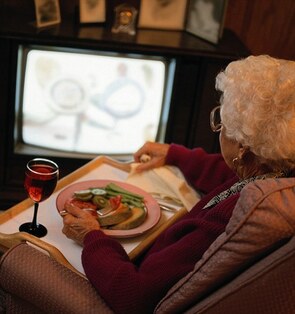 When I visited my grandma in the last few years of her life, we spent our time in front of a small TV watching Jeopardy and Wheel of Fortune. She loved those shows, shouting out answers, cursing as contestants who spewed “stupid” answers, gushing over funny quips from “Alex” (Trebek) and “Pat” (Sajak). She referred to them by first names only: Alex and Pat. To her they were good friends. Even as a teenager, I worried about all the TV she watched. Being strapped to an oxygen tank in a one-bedroom garage apartment didn’t allow for much mobility, so leisurely activities were limited. There wasn’t much to do but eat and watch TV when I visited. It made her happy. Sure, she was happy I was there, but TV made her happy even when I wasn’t. TV was a functional surrogate. She laughed at Alex, her brain fully-engaged, rifling off answers (in the form of questions, of course) on Jeopardy. I later realized that grandma’s legendary crossword skills were particularly useful during Wheel of Fortune. This was the mid-80s. Grandma had one TV in the living room. There were no other screens. No iPads. No smartphones. Now we live in a world dominated by screens. My mom, like my grandma (her mother), is now homebound with limited mobility. I doubt my mom would be happy with just one screen. She likes TV, but she loves her iPhone. It’s always in her hand or charging nearby. That’s not a bad thing. Gretchen Livingston of the Pew Research Center reported last week that Americans over the age of 60 are spending more time on screens than a decade ago. “Screen time has increased for those in their 60s, 70s, 80s and beyond, and the rise is apparent across genders and education levels,” Livingston said. Of course, the increase in screen time is linked to a willingness among older Americans to actually adopt new technologies. But technology adoption didn’t happen overnight for older Americans. In the mid-2000s, more families started purchasing computers and other screens for older family member as a means for staying better connected. “In 2000, 14% of those ages 65 and older were internet users; now 73% are,” Livingston said. “And while smartphone ownership was uncommon at all ages around the turn of the 21st century, now about half of people 65 and older are smartphone owners.” My mom is a wonderful grandma to our kids. But participating in all grandkid-related activities can’t happen anymore. So for her, screen time is a must. She’s a wiz with that iPhone. She loves to text our kids, sharing funny videos and memes. TV made my grandma happy, but screen time makes my mom happy because she feels more connected to the world beyond the TV in her living room. Comments are closed.
|
AuthorDr. Adam C. Earnheardt is special assistant to the provost and professor of communication in the department of communication at Youngstown State University in Youngstown, OH, USA where he also directs the graduate program in professional communication. He researches and writes on a variety of topics including communication technologies, relationships, and sports (with an emphasis on fandom). His work has appeared in Mahoning Matters as well as The Vindicator and Tribune-Chronicle newspapers. CategoriesArchives
July 2023
|
 RSS Feed
RSS Feed